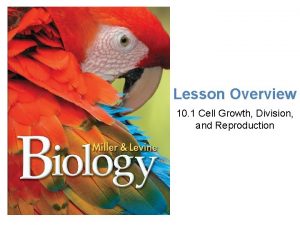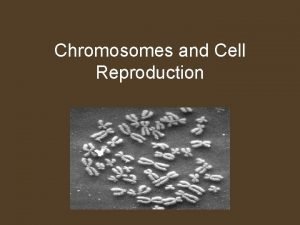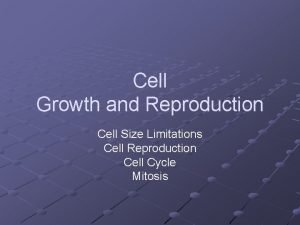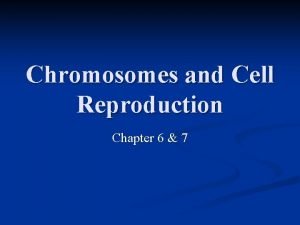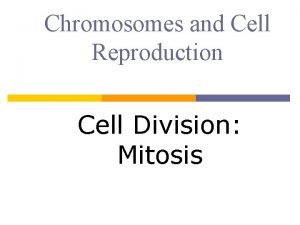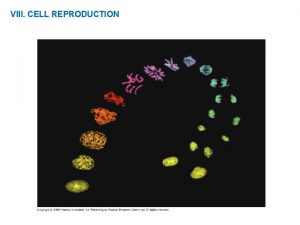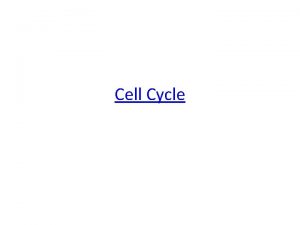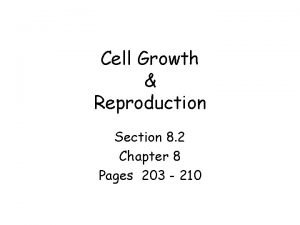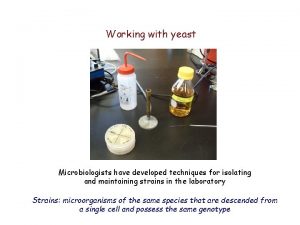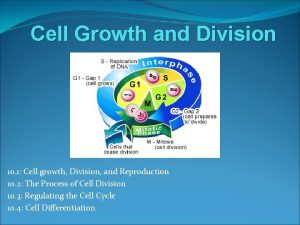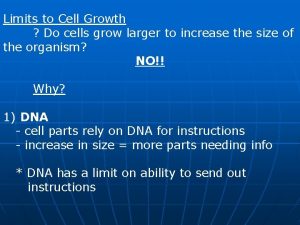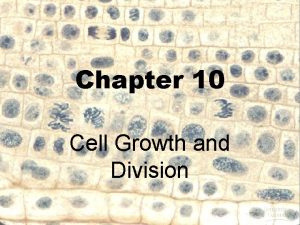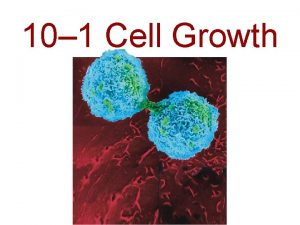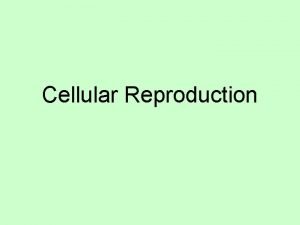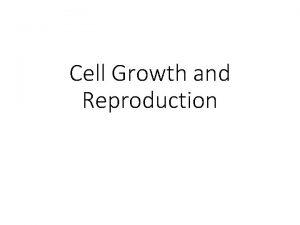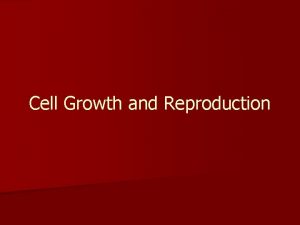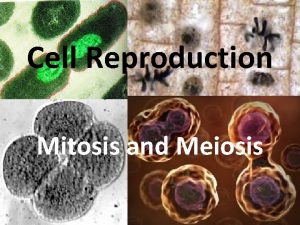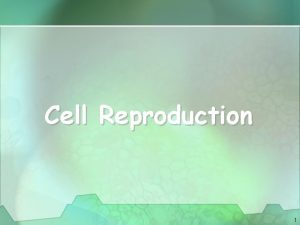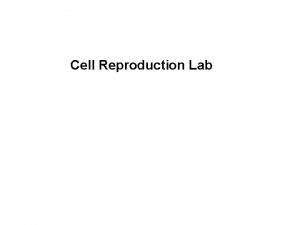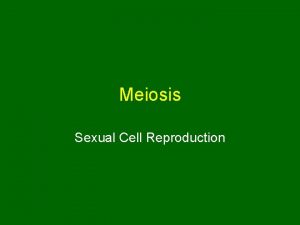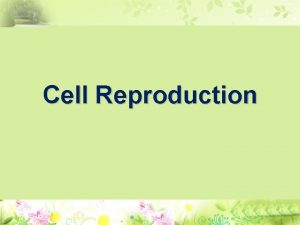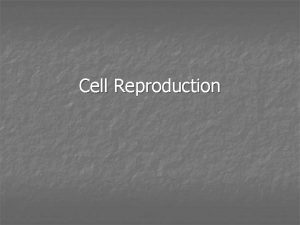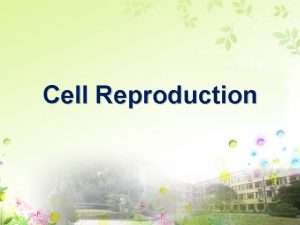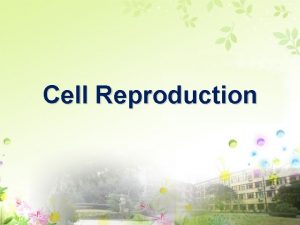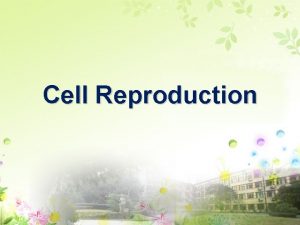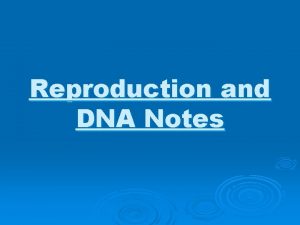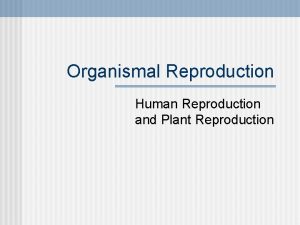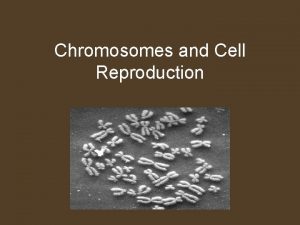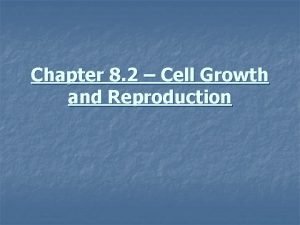Cell Growth and Reproduction Cell Growth and Reproduction







































- Slides: 39

Cell Growth and Reproduction

Cell Growth and Reproduction The Cell Life Cycle • The cell life cycle, the series of changes a cell goes through from the time it is formed until it reproduces, encompasses two major periods: interphase, in which the cell grows and carries on its usual activities, and cell division, or the mitotic phase, during which it divides into two cells

The Cell Cycle Interphase is the period from cell formation to cell division: • During G 1, cells grow rapidly and carry out their routine functions. • The S phase is the period of DNA synthesis. • In G 2, materials needed for cell division are synthesized and growth continues. Perhaps a more accurate name for this phase would be metabolic phase or growth phase.

Levels of packing of DNA in the nucleus • The DNA double helix is wrapped around protein complexes called histones- each unit of DNA wrapped round a histone complex is called a nucleosome. • The polynucleosome chain is further compacted to form solenoid structures. • The human nuclear DNA ( genome) consists of 23 pairs of chromosomes.

James Watson & Francis Crick 1962 Nobel Prize http: //www. sciencemag. org/cgi/content/full/300/5617/255 http: //www. lecb. ncifcrf. gov/~toms/icons/Watson. Crick. Nature. jpg

DNA (Deoxyribonucleic acid / Asam deoksiribonukleat) • DNA is a very large molecule made up of a long chain of sub-units • The sub-units are called nucleotides • Each nucleotide is made up of: 1. a sugar called deoxyribose 2. a phosphate group -PO 4 and 3. an organic base

Nucleotide

Organic Base Adenine (A) Thymine (T) Cytosine (C) Guanine (G)

Bonding PO 4 adenine thymine PO 4 cytosine guanine PO 4

THE DOUBLE HELIX bases sugar-phosphate chain

Degradation of nucleus DNA Nucleus Chromosome Nucleic Acid Nucleotide

DNA Replication • Before a cell can divide, its DNA must be replicated exactly, so that identical copies of the cell’s genes can be passed on to each of its offspring. • Replication begins simultaneously on several chromatin threads and continues until all the DNA has been replicated.

This process is called replication • During a cell divides, the DNA strands unwind and separate • Each strand makes a new partner by adding the appropriate nucleotides • The result is that there are now two doublestranded DNA molecules in the nucleus • So that when the cell divides, each nucleus contains identical DNA PO PO PO 4 PO The strands separate 4 4 4 PO 4 PO PO PO 4 4 4 4 PO PO 4 PO 4 PO 4 PO Each strand builds up its partner by adding the appropriate nucleotides 4 PO 4 4

Kemungkinan Pola Replikasi DNA Pola yang benar

This process appears to involve the following events: • The DNA helices begin unwinding from the nucleosomes. • A helicase enzyme untwists the double helix and gradually separates the DNA molecule into two complementary nucleotide chains, exposing the nitrogenous bases. • The site of separation is called the replication bubble; the Yshaped region at each end of the replication bubble is called the replication fork.

Cont. • Each nucleotide strand then serves as a template, or set of instructions, for building a new complementary nucleotide strand from free DNA precursors dissolved in the nucleoplasm. • Recall from Chapter 2 that nucleotide base pairing is always complementary: adenine (A) bonds to thymine (T), and guanine (G) bonds to cytosine (C).

Cont. • At sites where DNA synthesis is to occur, the needed “machinery” gradually accumulates until several different proteins (mostly enzymes) are present in a large complex called a replisome. • The actual initiation of DNA synthesis requires formation of short (about ten bases long) RNA primers by primase enzymes which are part of the replisome. • These primers are eventually erased and replaced with DNA nucleotides by DNA polymerases.

• As soon as replication ends, histones (synthesized in the cytoplasm and imported into the nucleus) associate with the DNA, completing the formation of two new chromatin strands. • Each DNA molecule formed consists of one old (template) strand one newly assembled strand constitutes a chromatid of a chromosome. • They are then distributed to the daughter cells, as described next, ensuring that each cell has identical genetic information.

Cell Division • Cell division is essential for body growth and tissue repair. • Events of Cell Division In most body cells, cell division, which is called the M (mitotic) phase of the cell life cycle, involves two distinct events: mitosis (mi-to′sis; mit = thread; osis = process), or division of the nucleus, and cytokinesis (si-to-kĭ-ne′sis; kines = movement), or division of the cytoplasm.

Mitosis is the series of events that parcel out the replicated DNA of the mother cell to two daughter cells. • It is described in terms of four phases: prophase, metaphase, and telophase, but it is actually a continuous process, with one phase merging smoothly into the next.



Control of Cell Division • The signals that prod cells to divide are poorly understood. • Two other mechanisms that influence when cells divide are chemical signals (growth factors, hormones, and others) released by other cells and the availability of space. • Normal cells stop proliferating when they begin touching, a phenomenon called contact inhibition. • Cancer cells lack many of the normal controls and therefore divide wildly, which makes them dangerous to their host.

Related Clinical Terms • Anaplasia (an″ah-pla′ze-ah; an = without, not; plas = to grow) Abnormalities in cell structure; for example, cancer cells typically lose the appearance of the parent cells and come to resemble undifferentiated or embryonic cells. • Dysplasia (dis-pla’ze-ah; dys = abnormal) A change in cell size, shape, or arrangement due to chronic irritation or inflammation (infections, etc. ). • Hypertrophy (hi-per′tro-fe) Growth of an organ or tissue due to an increase in the size of its cells. • Mutation A change in DNA base sequence leading to incorporation of incorrect amino acids in particular positions in the resulting protein; the affected protein may remain unimpaired or may function abnormally or not at all, leading to disease. • Necrosis (nĕ-kro′sis; necros = death; osis = process) Death of a cell or group of cells due to injury or disease.

EKSPRESI GEN

Protein Synthesis transcription DNA translation RNA Protein • Essentially, cells are miniature protein factories that synthesize the huge variety of proteins that determine the chemical and physical nature of cells. • Proteins are composed of polypeptide chains, which in turn are made up of amino acids. For purposes of this discussion, we can define a gene as a segment of a DNA molecule that carries instructions for creating one polypeptide chain (however, some genes specify the structure of certain varieties of RNA as their final product).

• The four nucleotide bases (A, G, T, and C) are the “letters” of the genetic dictionary, and the information of DNA is found in the sequence of these bases. • The sequence of bases in DNA forms the Genetic Code. • A group of three bases (a triplet) controls the production of a particular amino acid in the cytoplasm of the cell. • The different amino acids and the order in which they are joined up determines the sort of protein being produced.

RNA Codes for Amino Acids • The nitrogen bases in RNA code for amino acids. • A triplet of nitrogen bases codes for one amino acid. • The triplet is called a codon.

RNA differs from DNA in being single stranded and in having the sugar ribose instead of deoxyribose and the base uracil (U) instead of thymine (T). Three forms of RNA typically act together to carry out DNA’s instructions for polypeptide synthesis: • Transfer RNA (t. RNA), small, roughly cloverleaf-shaped molecules • Ribosomal RNA (r. RNA), part of the ribosomes • Messenger RNA (m. RNA), relatively long nucleotide strands resembling “half-DNA” molecules, or one of the two strands of a DNA molecule coding for protein structure

Perbedaan DNA RNA Letak Sebagian besar di nukleus, sedikit di mitochondria dan kloroplast Dalam sitoplasma, nucleolus dan kromosom Pyrimidine bases Cytosine Thymine Cytosine Urasil Purine bases Adenine Guanine Pentose deoxyribose Hydrolizing enzyme Deoxyribonuclease (DNase) Ribonuclease (RNase) Peranan Genetic information Synthesis of proteins

Essentially, polypeptide synthesis involves two major steps: • (1) transcription, in which DNA’s information is encoded in m. RNA, and • (2) translation, in which the information carried by m. RNA is decoded and used to assemble polypeptides.

Kode Genetik

Transcription • In cells, transcription involves the transfer of information from a DNA gene’s base sequence to the complementary base sequence of an m. RNA molecule.


Translation • In the translation step of protein synthesis, the language of nucleic acids (base sequence) is translated into the language of proteins (amino acid sequence). • The process of translation occurs in the cytoplasm.

• The transfer of information goes from DNA base sequence (triplets) to the complementary base sequence of m. RNA (codons) and then to the t. RNA base sequence (anticodons), which replicates that of DNA except for the substitution of uracil (U) for thymine (T).

Translation - animation


Chapter Test
 Cell growth division and reproduction
Cell growth division and reproduction Asexualk
Asexualk The disadvantages of sexual reproduction
The disadvantages of sexual reproduction Venn diagram of asexual and sexual
Venn diagram of asexual and sexual Growth and reproduction
Growth and reproduction Growth and reproduction
Growth and reproduction Chapter 6 chromosomes and cell reproduction
Chapter 6 chromosomes and cell reproduction Plant growth analysis
Plant growth analysis Monocots vs eudicots
Monocots vs eudicots Primary growth and secondary growth in plants
Primary growth and secondary growth in plants Chapter 35 plant structure growth and development
Chapter 35 plant structure growth and development Cell reproduction
Cell reproduction Mitosis sexual reproduction
Mitosis sexual reproduction Cell of reproduction
Cell of reproduction Cell reproduction
Cell reproduction Carothers equation
Carothers equation Geometric growth graph
Geometric growth graph Neoclassical growth theory vs. endogenous growth theory
Neoclassical growth theory vs. endogenous growth theory Organic growth vs inorganic growth
Organic growth vs inorganic growth Section 8-2 cell division
Section 8-2 cell division Yeast growth curve
Yeast growth curve 10-1 cell growth
10-1 cell growth Limits to cell growth
Limits to cell growth Section 10-1 cell growth
Section 10-1 cell growth Limits to cell growth
Limits to cell growth Advantages of diaphragm cell
Advantages of diaphragm cell Prokaryotic
Prokaryotic Venn diagram of organelles in plant and animal cells
Venn diagram of organelles in plant and animal cells Tonoplast
Tonoplast Rough er function
Rough er function Types of secondary cells
Types of secondary cells Difference between plant and animal cell
Difference between plant and animal cell Events of the cell cycle
Events of the cell cycle Prokaryotic cell and eukaryotic cell
Prokaryotic cell and eukaryotic cell The scientist mathias schleiden studied _______ in ______.
The scientist mathias schleiden studied _______ in ______. Idealized animal cell
Idealized animal cell Walker cell and hadley cell
Walker cell and hadley cell Cell cycle and cell division
Cell cycle and cell division Animal cells and plant cells venn diagram
Animal cells and plant cells venn diagram Cell cycle chart
Cell cycle chart
